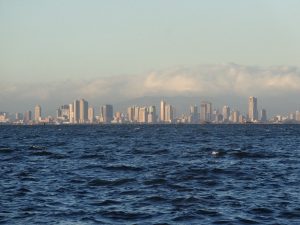On September 8, the Philippines’ Defense Secretary Delfin Lorenzana announced that he had signed a deal with a company called the Dito Telecommunity Corp., allowing it to build cellphone towers inside Philippine military bases. So far, so pedestrian – except for the fact that a 40 percent stake in Dito is owned by the Chinese state-owned China Telecommunications Corporation.
Coming at a time when the activities of Chinese technology firms are under increased global scrutiny over security fears, and given the Philippines’ ongoing disputes with China in the South China Sea, it was hardly a surprise that the announcement set off a small public relations blaze.
Retired Justice Antonio Carpio, formerly of the Philippines Supreme Court, and a staunch critic of the current administration, described the decision as “dumb.” “It’s like allowing China to put a listening device in your conference room,” the former magistrate said in an interview with CNN Philippines. Given its connections to the Chinese state, said Philippine Senator Ralph Recto, military bases “should be declared as no-go zones for this company.” (For what it’s worth, Lorenzana said that the Armed Forces of the Philippines would “institute safeguards” to protect the security of its bases).
Lorenzana’s announcement came a day after the chief of the Philippines Navy voiced his public opposition to the relocation of an important naval base to make room for a $10.2 billion airport that will be built by a Chinese firm recently blacklisted by the U.S. government.
The Sangley Point International Airport project was approved by President Rodrigo Duterte on September 1, and will involve the expansion of an existing airport and extensive land reclamation in Manila Bay. A joint venture between China Communications Construction Company (CCCC) and the local MacroAsia conglomerate, the new air hub is intended to ease congestion at Manila’s chaotic Ninoy Aquino International Airport.
Vice Admiral Giovanni Carlo Bacordo said that the planned relocation of the Sangley Point naval station, which faces onto Manila Bay (and thence onto the disputed South China Sea), would leave the Philippine capital exposed to attack. “It is guarding the entrance to Manila Bay and Manila Bay is the center of gravity of the national government,” he said. “If Manila falls, the whole country falls.”
Bacordo also raised concerns about doing business with CCCC, one of 24 Chinese entities recently sanctioned by the U.S. government for their role in China’s dredging and construction of artificial islands in disputed parts of the South China Sea.
Last week, President Rodrigo Duterte said he would ignore the U.S. sanctions and allow the blacklisted Chinese firms to participate in his multi-billion dollar “Build, Build, Build” infrastructure scheme. Presidential spokesperson Harry Roque said that Duterte would “not follow the directives of the Americans because we are a free and independent nation, and we need investors from China.”
The two deals highlights once again the divisions within the Philippines’ government over Duterte’s lurching foreign alignments. Since trolling his way into office in 2016, Duterte has cozied up to Beijing while spurning the U.S., the country’s former colonial ruler and long-standing treaty ally. Hoping to tap China for badly needed infrastructure funding, he has downplayed Chinese actions in the South China Sea (despite his frequent tough talk) and soft-pedaled a July 2016 international legal ruling in the Philippines’ favor.
Coming more than four years into Duterte’s six year term, these sorts of controversies continue to flow logically from the contradictions he has injected into Philippine foreign policy, which seeks U.S. support to counter Chinese assertiveness in the South China Sea, while seeking Beijing’s cooperation on the development of the country’s infrastructure. They paint a picture of an administration that can’t decide whether it should be courting China, or shunning it.

































